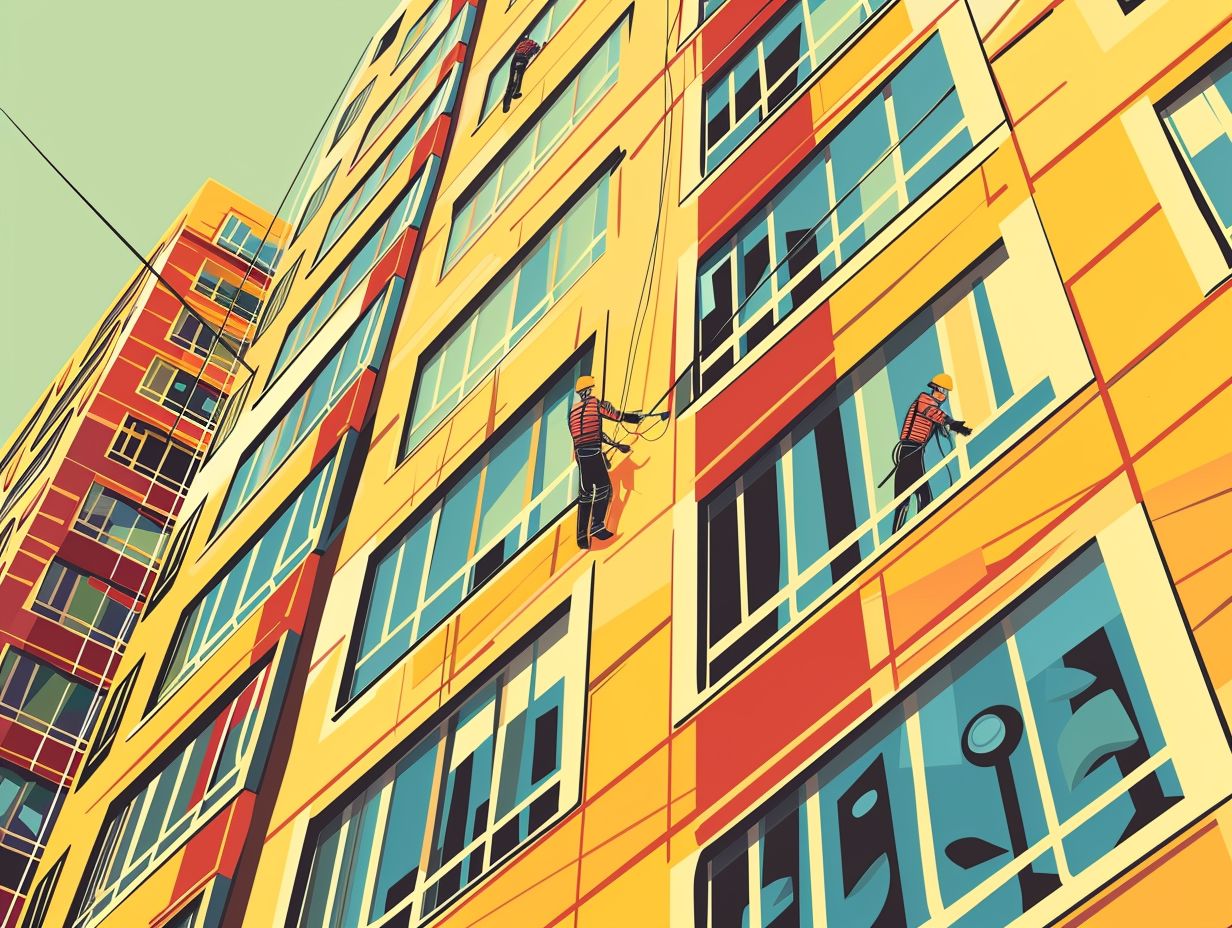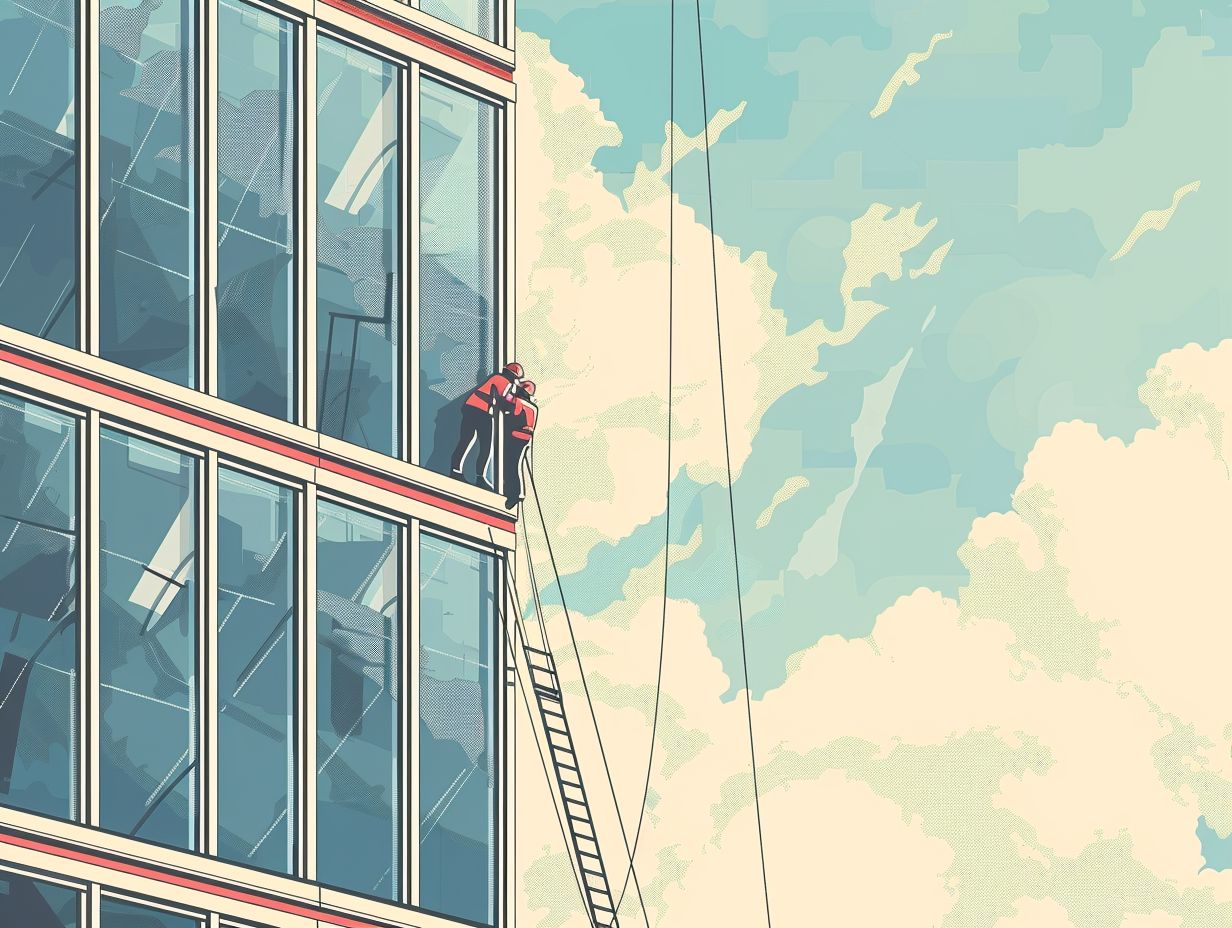High rise window cleaning is a specialized and potentially hazardous job that requires strict adherence to laws and regulations to ensure the safety of workers and the public.
In this article, we will explore the importance of regulatory frameworks in high rise window cleaning, the specific laws and regulations that govern the industry, and the requirements that must be met by companies and workers.
We will also discuss the potential risks of non-compliance and provide tips on how high rise window cleaning companies can ensure they are following the necessary guidelines.
Get ready to navigate the world of high rise window cleaning laws and regulations with us.
What Are Regulatory Frameworks?

Regulatory frameworks are essential structures established by governing bodies to ensure compliance with laws and safety regulations within specific industries. These frameworks provide a set of guidelines and standards that must be adhered to by organizations and individuals to maintain legal compliance and ensure industry standards are met.
They play a crucial role in ensuring that businesses operate in a responsible and ethical manner, safeguarding the well-being of workers and the general public. By setting clear rules and requirements, regulatory frameworks help prevent misconduct, promote fair competition, and protect consumers from harm. These standards foster innovation by encouraging companies to invest in research and development to meet regulatory demands, ultimately leading to advancements in technology and services within the industry.
Why Are Regulatory Frameworks Important for High Rise Window Cleaning?
Regulatory frameworks play a crucial role in high rise window cleaning operations due to the inherent risks associated with working at heights. Compliance with safety regulations, such as those set by the Occupational Safety and Health Administration (OSHA), is paramount to ensure the well-being of workers and the public during window cleaning activities.
These regulations not only serve to protect workers from potential hazards like falls and dangerous equipment handling but also uphold the integrity of the structures being cleaned. By mandating safety protocols, regulatory frameworks contribute to reducing accidents and ensuring a systematic approach to high rise window cleaning practices. Adhering to these guidelines enhances efficiency, minimizes downtime due to accidents, and instills confidence in clients regarding the professionalism and reliability of the cleaning service providers.
What Are the Laws and Regulations for High Rise Window Cleaning?
The laws and regulations governing high rise window cleaning encompass a range of aspects, including building codes, safety regulations, and specific OSHA regulations tailored to address the unique challenges of working at heights. Compliance with these laws is essential for ensuring the safety of workers and the public, as well as maintaining legal obligations within the industry.
Building codes play a crucial role in dictating the design and construction specifications of high rise buildings, impacting the accessibility and safety measures for window cleaning operations. Safety regulations, such as those outlined by OSHA, set clear guidelines for the use of personal protective equipment, fall protection systems, and regular training programs to mitigate risks associated with working at elevated heights.
Understanding and adhering to these regulations not only safeguard workers but also demonstrate a commitment to upholding industry standards and legal compliance in the high rise window cleaning sector.
Occupational Safety and Health Administration (OSHA)
The Occupational Safety and Health Administration (OSHA) sets forth stringent safety regulations that govern high rise window cleaning activities. Compliance with OSHA standards is crucial, requiring worker training in fall protection measures and adherence to strict safety protocols to mitigate risks associated with working at heights.
OSHA mandates that employers provide comprehensive training to workers involved in high rise window cleaning to ensure they are equipped with the necessary skills and knowledge to safely perform their duties. This training includes instruction on the proper use of personal protective equipment (PPE), techniques for working at heights, emergency procedures, and hazard recognition. By investing in thorough training programs, companies can not only enhance the safety of their employees but also maintain compliance with OSHA regulations, thereby reducing the likelihood of accidents and injuries on the job.
National Institute for Occupational Safety and Health (NIOSH)
The National Institute for Occupational Safety and Health (NIOSH) plays a key role in establishing safety regulations and compliance standards related to hazardous materials and worker safety in high-rise window cleaning. Adhering to NIOSH guidelines is essential to safeguard the health and well-being of workers exposed to potential occupational hazards.
These regulations cover a wide range of safety measures, including the proper handling and disposal of hazardous materials, the use of personal protective equipment, training programs for workers, and regular inspections to ensure compliance.
NIOSH regulations also emphasize the importance of risk assessment and hazard communication to promote a culture of safety in high-risk activities like window cleaning in tall buildings.
By following NIOSH guidelines, companies can reduce the risk of accidents, injuries, and long-term health effects associated with exposure to dangerous substances.
American National Standards Institute (ANSI)
The American National Standards Institute (ANSI) establishes equipment standards, safety procedures, and compliance documentation requirements for high-rise window cleaning operations. Ensuring compliance with ANSI guidelines is essential for obtaining safety certifications and maintaining industry best practices.
These standards set forth by ANSI are crucial in promoting safe practices in the high-rise window cleaning industry. By following these guidelines, professionals can minimize the risks associated with working at heights and ensure the well-being of both workers and building occupants. Adhering to ANSI standards not only enhances safety but also boosts credibility and trust with clients. Safety certifications obtained through compliance with ANSI regulations validate a company’s commitment to excellence and professionalism in the field, setting them apart as reliable and reputable service providers.
International Window Cleaning Association (IWCA)

The International Window Cleaning Association (IWCA) establishes industry standards, safety compliance protocols, safety training programs, and regulatory updates for the high rise window cleaning sector. Adhering to IWCA guidelines is essential for maintaining safety compliance and staying informed about regulatory changes.
This association plays a crucial role in promoting a culture of safety within the industry through the development of best practices and standards that ensure the well-being of workers and the public. By setting these guidelines, IWCA not only enhances the professionalism of high rise window cleaning but also reduces the risks associated with this challenging work. Their safety training programs equip workers with the necessary skills to handle complex tasks safely and efficiently, ultimately leading to a safer working environment for all.
What Are the Requirements for High Rise Window Cleaning?
High rise window cleaning requires rigorous adherence to specific requirements, including comprehensive training and certification programs for workers, compliance with equipment standards to ensure safety, and securing adequate insurance coverage to mitigate potential risks associated with the job.
Training and certification play a crucial role in equipping personnel with the knowledge and skills necessary to navigate the complexities of high rise cleaning operations safely. Certified workers are trained to handle specialized equipment, understand proper anchoring techniques, and follow strict safety protocols.
Adherence to equipment standards, such as using tested and approved gear like harnesses, ropes, and platforms, is essential for ensuring the integrity of the cleaning process. Having comprehensive insurance coverage provides financial protection against any unforeseen accidents or liabilities that may arise during window cleaning tasks.
Training and Certification
Training and certification play a vital role in high rise window cleaning, encompassing specific requirements for safety training programs, worker certification, compliance audits, and safety management protocols to ensure the competence and preparedness of personnel engaged in high altitude work.
Safety training programs are designed to equip workers with the necessary knowledge and skills to handle the unique challenges of working at great heights. Worker certification validates their competency and adherence to safety standards, providing assurance to clients that the tasks will be executed professionally. Compliance audits ensure that safety measures are consistently met and identify areas for improvement. Effective safety management practices involve regular training updates, on-site safety inspections, and emergency response protocols to maintain a safe working environment for all involved.
Proper Equipment and Safety Measures
Utilizing proper equipment and implementing stringent safety measures are essential components of high rise window cleaning operations. Adherence to equipment standards, use of personal protective equipment (PPE), and regular maintenance of equipment ensure worker safety and compliance with industry regulations.
- High rise window cleaning requires specialized equipment such as bosun’s chairs, platforms, and scaffolding that meet stringent industry standards to ensure stability and reliability at great heights.
- Workers must also use appropriate PPE like harnesses, helmets, and gloves to protect themselves from hazards.
Implementing safety procedures, such as thorough risk assessments and clear communication protocols, minimizes the potential for accidents. Regular inspection and maintenance of equipment, including ropes and pulleys, is crucial to prevent failures that could endanger workers and property below.
Insurance Coverage
Securing adequate insurance coverage is a critical requirement for high rise window cleaning companies to protect against potential liabilities, accidents, and property damage. Compliance with insurance requirements, regular reviews, and obtaining insurance certifications are key elements in ensuring comprehensive coverage.
Insurance coverage not only safeguards against unforeseen events but also provides a level of security and peace of mind for both the company and its clients.
By meeting insurance requirements and undergoing compliance reviews, companies can demonstrate their commitment to safety and risk management.
Policies such as general liability insurance and workers’ compensation are essential for protecting workers and clients in the event of accidents.
Insurance certifications offer proof that a company is adequately covered, which can enhance credibility and trust within the industry.
What Are the Risks of Non-Compliance with Regulatory Frameworks?
Non-compliance with regulatory frameworks in high rise window cleaning can lead to severe consequences, including injuries and fatalities resulting from fall hazards, legal repercussions due to violations of safety regulations, and damage to the company’s reputation and business integrity.
The risk of on-site accidents and fatalities due to improper safety measures is a major concern in non-compliant window cleaning practices. Inadequate training and equipment maintenance could result in workers sustaining serious injuries or even losing their lives. Failure to adhere to safety protocols can also result in costly legal battles and fines for violating industry standards. Such incidents not only tarnish the company’s reputation but also lead to financial losses and potential business shutdowns, making it imperative for organizations to prioritize safety compliance to avoid such detrimental outcomes.
Injuries and Fatalities

Non-compliance with regulatory frameworks in high rise window cleaning heightens the risk of injuries and fatalities due to accidents that could have been prevented with proper safety measures, emergency response plans, and adherence to workplace safety protocols.
- Ensuring that all personnel involved in high rise window cleaning are adequately trained in safety procedures and equipped with the necessary protective gear is essential for accident prevention.
- In the event of an emergency, having a well-defined emergency response plan in place can significantly reduce the severity of incidents.
- Regular safety inspections, risk assessments, and communication of safety protocols among team members are crucial components in maintaining a safe working environment and minimizing the potential for injuries and fatalities.
Legal Consequences
Non-compliance with regulatory frameworks can lead to significant legal consequences for high rise window cleaning companies, including fines, penalties, and potential legal actions from compliance officers, regulatory authorities, and entities responsible for enforcing building codes and safety regulations.
In order to avoid facing these legal repercussions, it is crucial for companies engaged in high-rise window cleaning to prioritize compliance documentation and adhere diligently to regulatory standards. Compliance officers play a vital role in inspecting and ensuring that businesses comply with all relevant laws and regulations.
Code enforcement agencies work closely with regulatory authorities to monitor and enforce compliance, issuing fines and penalties when necessary to uphold safety measures and prevent any potential hazards in high-rise buildings. Therefore, maintaining a strong focus on compliance and regulatory adherence is essential for the smooth operation and legal compliance of high-rise window cleaning companies.
Damage to Reputation and Business
Non-compliance with regulatory frameworks can tarnish the reputation and integrity of high-rise window cleaning companies, leading to loss of trust among clients, negative publicity, and potential business disruptions. Regular compliance reviews, adherence to regulatory updates, and effective risk mitigation strategies are essential to safeguarding reputation and business interests.
Maintaining trust is paramount in the service industry, especially for companies involved in high-risk operations such as window cleaning on tall buildings. Negative publicity resulting from non-compliance incidents can spread rapidly and damage the credibility that these businesses have worked hard to establish.
By prioritizing adherence to industry regulations and implementing robust risk mitigation measures, these companies can not only protect their reputation but also demonstrate their commitment to safety and professionalism to their clients and stakeholders.
How Can High Rise Window Cleaning Companies Ensure Compliance with Regulatory Frameworks?
High rise window cleaning companies can ensure compliance with regulatory frameworks by prioritizing regular training and education for workers, conducting thorough equipment maintenance and inspections, and implementing regular audits and compliance checks to monitor adherence to safety regulations and industry standards.
This commitment to ongoing training is crucial as it ensures that workers stay informed of the latest safety protocols and best practices.
In addition to training, companies should establish a robust system for maintaining and inspecting equipment to ensure that it meets safety standards. Regular audits provide a valuable opportunity to identify areas for improvement and address any potential compliance issues promptly.
Continuous improvement and monitoring are key aspects of a successful compliance strategy, helping companies stay ahead of regulatory changes and uphold a culture of safety and excellence.
Regular Training and Education
Regular training and education initiatives are vital for high rise window cleaning companies to ensure workforce competence, safety compliance, and adherence to industry guidelines. Conducting worksite evaluations, offering safety training courses, and maintaining compliance documentation are essential components of fostering a culture of safety and regulatory compliance.
By regularly engaging employees in training programs, companies can equip their workers with the necessary skills and knowledge to handle the unique challenges of high-rise window cleaning effectively.
Worksite evaluations play a crucial role in identifying potential risks and hazards, allowing for targeted safety measures to be implemented.
Safety training courses not only enhance employees’ competency in using specialized equipment but also instill a safety-first mindset.
Compliance documentation serves as a record of adherence to regulations and standards, demonstrating a commitment to maintaining a safe working environment.
Proper Equipment Maintenance and Inspections
High rise window cleaning companies must prioritize proper equipment maintenance and regular inspections to ensure compliance with safety standards and regulations. Following the permitting process, conducting safety inspections, and adhering to equipment maintenance schedules are critical for enhancing workplace safety and regulatory compliance.
Implementing a systematic approach to equipment maintenance not only prolongs the lifespan of the tools but also significantly reduces the risk of accidents and injuries in high-rise cleaning operations. Regular inspections help identify any potential issues or defects in the equipment, allowing for timely repairs and replacements to be made. By adhering to established equipment standards and safety protocols, companies can create a safe working environment for their employees and uphold industry regulations. Consistent monitoring of equipment conditions and conducting routine inspections are essential practices for maintaining a high level of safety and efficiency in window cleaning operations.
Regular Audits and Compliance Checks

Conducting regular audits and compliance checks is essential for high rise window cleaning companies to evaluate safety compliance, develop effective safety protocols, review regulatory compliance plans, and ensure alignment with industry best practices. Compliance officers play a key role in overseeing these audits and assessments.
Ensuring that safety protocols are up-to-date and in line with current regulations is crucial for maintaining a safe working environment for employees and ensuring the protection of the public. Compliance officers are tasked with not only conducting audits but also with identifying areas of improvement in safety procedures, providing recommendations for enhancements, and monitoring adherence to safety standards. By staying vigilant in their compliance checks, companies can mitigate risks, prevent accidents, and uphold a reputation for professionalism and safety in the high-rise window cleaning industry.
Frequently Asked Questions
What is a regulatory framework?
ANSWER: A regulatory framework refers to a set of rules, regulations, and guidelines that govern a particular industry or activity. In the context of high rise window cleaning, it includes laws and regulations that ensure the safety and compliance of workers and building owners.
Why are there specific laws for high rise window cleaning?
ANSWER: High rise window cleaning involves working at great heights, which poses significant risks to workers. Therefore, there are specific laws and regulations in place to ensure the safety of workers and the public, and to regulate the use of equipment and techniques.
What are some common laws and regulations for high rise window cleaning?
ANSWER: Some common laws and regulations for high rise window cleaning include requirements for proper training and certification, limitations on the use of certain equipment, guidelines for the use of personal protective equipment, and regulations for the disposal of waste and chemicals.
Who is responsible for complying with these laws and regulations?
ANSWER: Both the building owner and the window cleaning company are responsible for complying with these laws and regulations. The building owner must ensure that the company they hire follows all safety and compliance requirements, while the company must adhere to these regulations in order to protect their workers and the public.
What happens if a company or building owner does not comply with the regulatory frameworks for high rise window cleaning?
ANSWER: Failure to comply with the regulatory frameworks for high rise window cleaning can result in serious consequences, such as fines, penalties, and even legal action. Non-compliance also puts workers and the public at risk, which can result in accidents and injuries.
How can I ensure that my window cleaning company is complying with all laws and regulations?
ANSWER: To ensure that your window cleaning company is complying with all laws and regulations, make sure to thoroughly research their credentials, certifications, and safety record. You can also ask for proof of training and insurance, and make sure they have a detailed safety plan in place.




